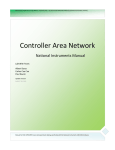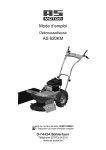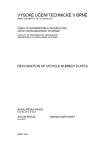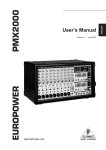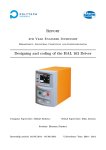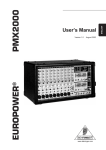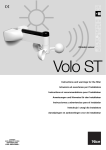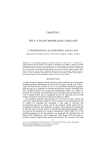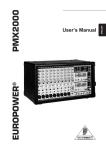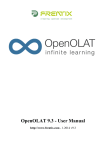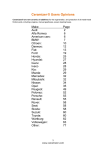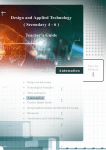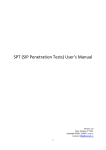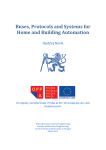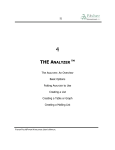Download ENGLISH TITLE - mnet.mendelu.cz.
Transcript
CROSS FLOW HEAT EXCHANGER PROCESS ANALYZE BY LABVIEW ANALÝZA DĚJŮ V KŘÍŽOPROUDÉM VÝMĚNÍKU TEPLA POMOCÍ PROGRAMU LABVIEW Holoubek L., Kukla R. Ústav zemědělské, potravinářské a environmentální techniky, Agronomická fakulta, Mendelova zemědělská a lesnická univerzita v Brně, Zemědělská 1, 613 00 Brno, Česká republika. E-mail: [email protected], [email protected] ABSTRACT This contribution deals how we can analyze thermo mechanical process in agriculture and food processing industry by LabVIEW. I have been used a multifunction card from National InstrumentsTM as device for data acquisition. Control this device has been by LabVIEWTM. LabVIEWTM also ensure well arranged display and save the measured out data. This assembly has been used to measure character of heat exchanger. A heat exchange is inseparable part of most agriculture and food technology. For that reason it is necessary have got a good knowledge about this process. Keywords: LabVIEW, Industrial Control, Measure, Automation ABSTRAKT Tento článek popisuje jak můžeme analyzovat termomechanické procesy v zemědělském a potravinářském průmyslu pomocí programu LabVIEW. Zajímal jsem se o termomechanické procesy které nastávají při sdílení tepla v křížoproudém tepelném výměníku. Při měření jsem použil multifunkční měřící kartu od firmy National Instruments ke sběru dat a vlastní měření pak probíhalo v programu LabVIEW. LabVIEW také obstarával zobrazování probíhajícího měření na monitoru a ukládání naměřených dat. Tepelný výměník je dnes nedílnou součástí většiny zemědělských a potravinářských technologií stejně tak i zemědělských strojů. Proto je nezbytné mít o tomto procesu dobré znalosti. Klíčová slova: LabVIEW, průmyslové řízení, měření, automatizace PREFACE In the society development process the man first according to his ability, possibility and interest he began liberation from hard and repetitive physical work (mechanization). Later then, with next development of techniques and growth necessity to control procedure, he came up to exempt from often very hard control brainwork (automatization). Flux is indivisibility part of our age. We are permanently amazed by new possibility of technology, which already install in our lives and work and affect how we working, communicating together and haw we unwinding. Computers long ago aren’t machine to mere calculation, although unbelievably fast and accurate. Computer became universal machine to processing, transfer and storage information. At the same time their versatility is really amazing. Perchance there is no other human product, which would come in useful in so many activities. Main function in control system is taking over software. Hardware is mostly uniform and interchangeable. Only software is that layer witch whole system does a unique and specific as consumers need. LabVIEW is a graphical programming language that uses icons instead of lines of text to create applications. In contrast to text-based programming languages, where instructions determine program execution, LabVIEW uses dataflow programming, where the flow of data determines execution. The fundamental task of all measurement systems is the measurement and/or generation of real-world physical signals. Measurement devices help you acquire, analyze, and present the measurements you take. Through data acquisition, you acquire and convert physical signals, such as voltage, current, pressure, and temperature, into digital formats and transfer them into the computer. Popular methods for acquiring data include plug-in DAQ and instrument devices, GPIB instruments, PXI (PCI eXtensions for Instrumentation) instruments, and RS-232 instruments. METHODICAL INTERPRETATION Method of measurement The aim of this project has been performed measure base for process measure in heat exchanger. Measure has been ensured multifuntion card from National Instuments PCI – 6251. This multifuntion card include 16 analog inputs and 2 analog outputs. Furthermore include 24 digital chanels which everyone can be used as input or output. This card is marked as “High-speed” becouse can ensure aggregate sampling rate 1,25 MS/s. This card can ensure considerably fast and exact measure than temperature require. As bridge betvween hardware and software serve a device driver. In this case has been used NI-DAQmx also from National Instruments. NI-DAQ is abbreviation for National Instruments Data Acquisition. Through this bridge LabVIEW communicate with measuring card. NI-DAQ is special developed software for National Instrumnt devices. As programming language for data acqusition has been used LabVIEW. LabVIEW is a graphical programming language that uses icons instead of lines of text to create applications. In LabVIEW, we can build a user interface with a set of tools and objects. The user interface is known as the front panel. We can then add code using graphical representations of functions to control the front panel objects. The block diagram contains this code. In some ways, the block diagram resembles a flowchart. LabVIEW programs are called virtual instruments, or VIs, because their appearance and operation imitate physical instruments, such as oscilloscopes and multimeters. Every VI uses functions that manipulate input from the user interface or other sources and display that information or move it to other files or other computers. We can build the front panel with controls and indicators, which are the interactive input and output terminals of the VI, respectively. Controls are knobs, push buttons, dials, and other input devices. Indicators are graphs, LEDs, and other displays. Controls simulate instrument input devices and supply data to the block diagram of the VI. Indicators simulate instrument output devices and display data the block diagram acquires or generates. After we build the front panel, we add code using graphical representations of functions to control the front panel objects. The block diagram contains this graphical source code. Front panel objects appear as terminals on the block diagram. Heat exchanger Heat exchanger is device built for efficient heat transfer from one fluid to another and is widely used in engineering processes. Some examples are intercoolers, preheaters, boilers and condensers in power plants. A heat exchanger utilizes the fact that heat transfer occurs when there is a difference in temperature. In a heat exchanger, there is a cold air and a hot water. The two mediums streams are separated by a thin, solid wall. The wall must be thin and conductive in order for heat exchange to occur. Yet the wall must be strong enough to withstand any pressure by he fluid. Copper seems to be one of a common choice for construction. We have used a recuperative type heat exchange, in which fluids exchange heat on either side of a dividing wall. The recuperative type of heat exchanger which is the most common in practice may be designed according to one of the following types: Parallel-flow Counter-flow Cross-flow In our case we have used cross-flow heat exchanger. In a cross-flow heat exchanger the direction of fluids are prependicular to each other. The required surface area, across for this heat exchanger is usually calculated by using tables. PROBLEM SOLVING For determination of heat outputs (flow of heats) heating and heated median is necessity measure their mass rate of flow and temperature before and behind recuperative exchanger. Measuring these quantitys allows measuring track (Pict. 1). Heating medium is warming up by electric heater (6) in pressure vessel (10). Pump (5) transporting hot water through area-type flowmeter (4) to the recuperative exchanger (3). Input and output temperature is measured thermocouples (1) and (8). Warming up medium – air, entering through a special designed jet (11) to the recuperative exchanger. Velocity of air is measured by anemometr (9) and at the same time sensor (2) measuring temperature and relative humidity. Air flow makeing ventilator (7). This is cross-flow recuperative heat exchanger water x air. Picture 1 - Measuring track of cross-flow recuperative heat exchanger To ensure measuring all above mention physical quantity I have created measuring set. This set has composited from LabVIEW as software and data acquisition card and sensors as hardware. LabVIEW and data acquisition card are from National Instruments company. This set can ensure very fast measuring all physical quantity what we need. All measured data are synoptically displaying and saving it to database file. This saved data can be subsequently analysed and processed. Temperature and relative humidity of air flow are measured in front of heat exchanger and behind it. We have used special probes HX94C from OMEGA.com Company. They are compound probes because include sensors for temperature and humidity measuring. These probes had current output 4 – 20 mA. A 4 to 20 milliamp loop is a series current loop in which a transmitter will vary the current flow depending upon the parameter being measured (Relative Humidity or Temperature). Advantages of a current outputs over a voltage output is that it is less susceptible to noise interference and allows the connection of more than one meter to the loop as long as the maximum resistance is not exceeded. Anemometer is from OMEGA.com Company too. All probes are connected to BNC 2120. BNC - 2120 is connector accessory for multifunction DAQ devices. It is a desktop accessory connected with multifunction card and place where we can connect probes via BNC connectors. Our data acquisition card includes 8 differential analog inputs. 4 inputs are used HX94C probes measuring airflow in front of and behind heat exchanger. One input is used by anemometer and two are used by thermocouples. Thermocouples are also from OMEGA.com. We used total 7 analog inputs one is unused. In LabVIEW a have been created program for reading this seven channels. Communication between LabVIEW and probes has been ensured with the assistance of NIDAQmx driver. Communication with one probe in LabVIEW is demonstrated on picture 2. Communication with all seven channels is pack up into one virtual instrument DAQ PCI 6251 obvious from picture 3. Crude measured data are adjusted in Amplitude and Level Measurements. Picture 3 displays whole easy program. Front panel this application is displayed on picture 4. Every indicator from front panel has owns shortcut in block diagram of code. Program is created wiring constituent elements. To ensure continuous running is whole program in a loop. Program is finished after press to button STOP or when some error occurs in program. When we will equip this measuring track with flow meter which has an electronic output we could connect him to data acquisition card too. This card is including two counter input. Picture 2 – Communication with one probe in LabVIEW via NI-DAQmx Picture 3 – Code of measure circuit Picture 4 – Front panel RESULT OF MEASUREMENT, DISCUSSION AND CONCLUSION Task has been crated measuring base for measure and analyse physical process in recuperative cross flow heat exchanger. I have used LabVIEW as developmental environment tool for program creation. I have monitoring temperature and relative humidity in front of and behind heat exchanger. Further has been monitoring air flow by anemometer and water incoming a outputing from heat exchanger. Incoming a outputing water has been measured by termocouples. Signals from all probes have been connected to BNC 2120 connector which has been connected to PCI 6251 data acquisition card in PC. Measured data has been saved to file on the disk. Data saving has been ensured by “Write LabVIEW Measurement File” Express virtual instrument generates. The LabVIEW data file is a tab-delimited text file we can open with a spreadsheet application or a text-editing application. In addition to the data an Express VI generates, the .lvm file includes information about the data, such as the date and time the data was generated. In LabVIEW I have created program to read data from probes, adjust them and display it. This aplication will serve for analyse thermomechnical process in our laboratory or elsewhere where it will necessary. It can secure very exact and fast measuring. This article showed only a fraction plentiful possibility which LabVIEW has. LabVIEW is a powerful tool to create easy small programs same as huge extensive aplications. BIBLIOGRAPHY [1] LabVIEW 7 Expres – User Manual, National Instruments, Austin Texas USA 2003 [2] LabVIEW 7 Expres – Measurements Manual, National Instruments, Austin Texas USA 2003 [3] NI-DAQ 7 – DAQ Quick Start Guide, National Instruments, Austin Texas USA 2005 [4] Measurement and Automation Catalog 2005, National Instruments, Austin Texas USA 2005 [5] HX95 SS RH Probe – User Guide, Omega Technologies Company, Stamfort Connecticut USA [6] GRODA B., Hydrotechnika a vzduchotechnika, VŠZ Brno 1990 This contribution was created in support of Mendel University of Agriculture and Forestry in Brno, Czech Republic. The number of grant is IGA 40/2005 and title “Analyse of thermomechanical process in agriculture and food processing industry”













